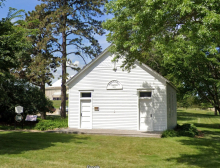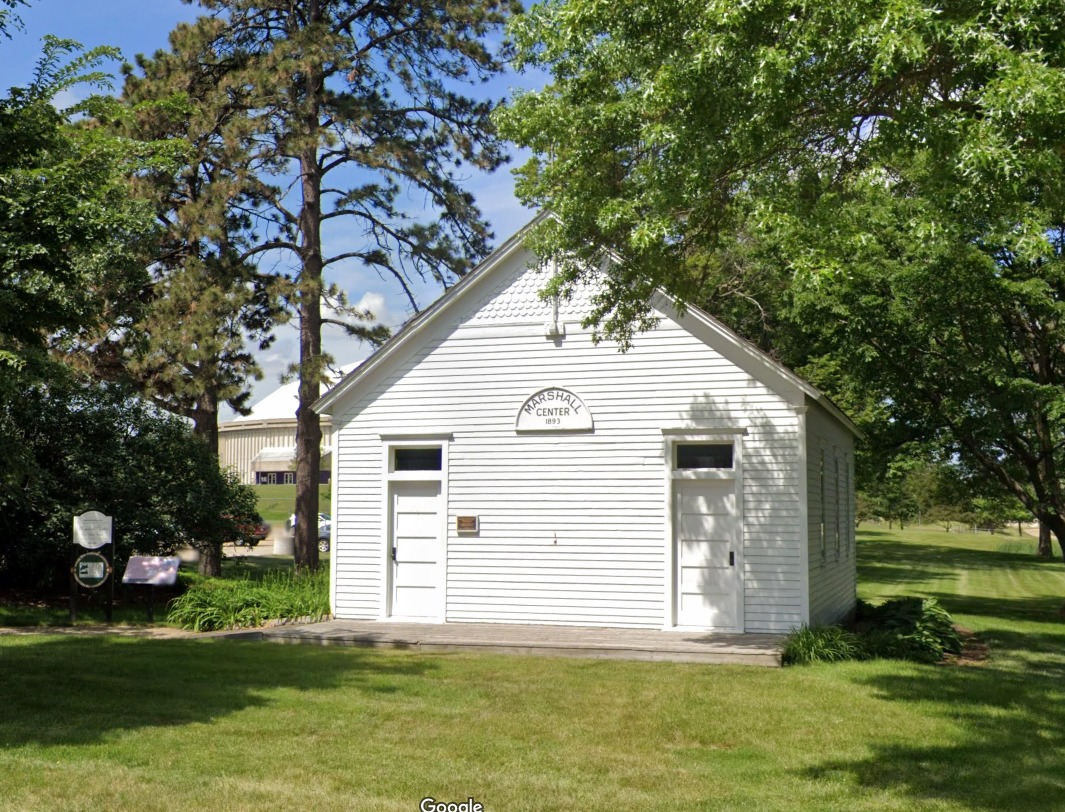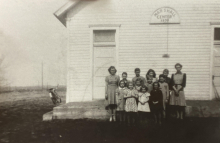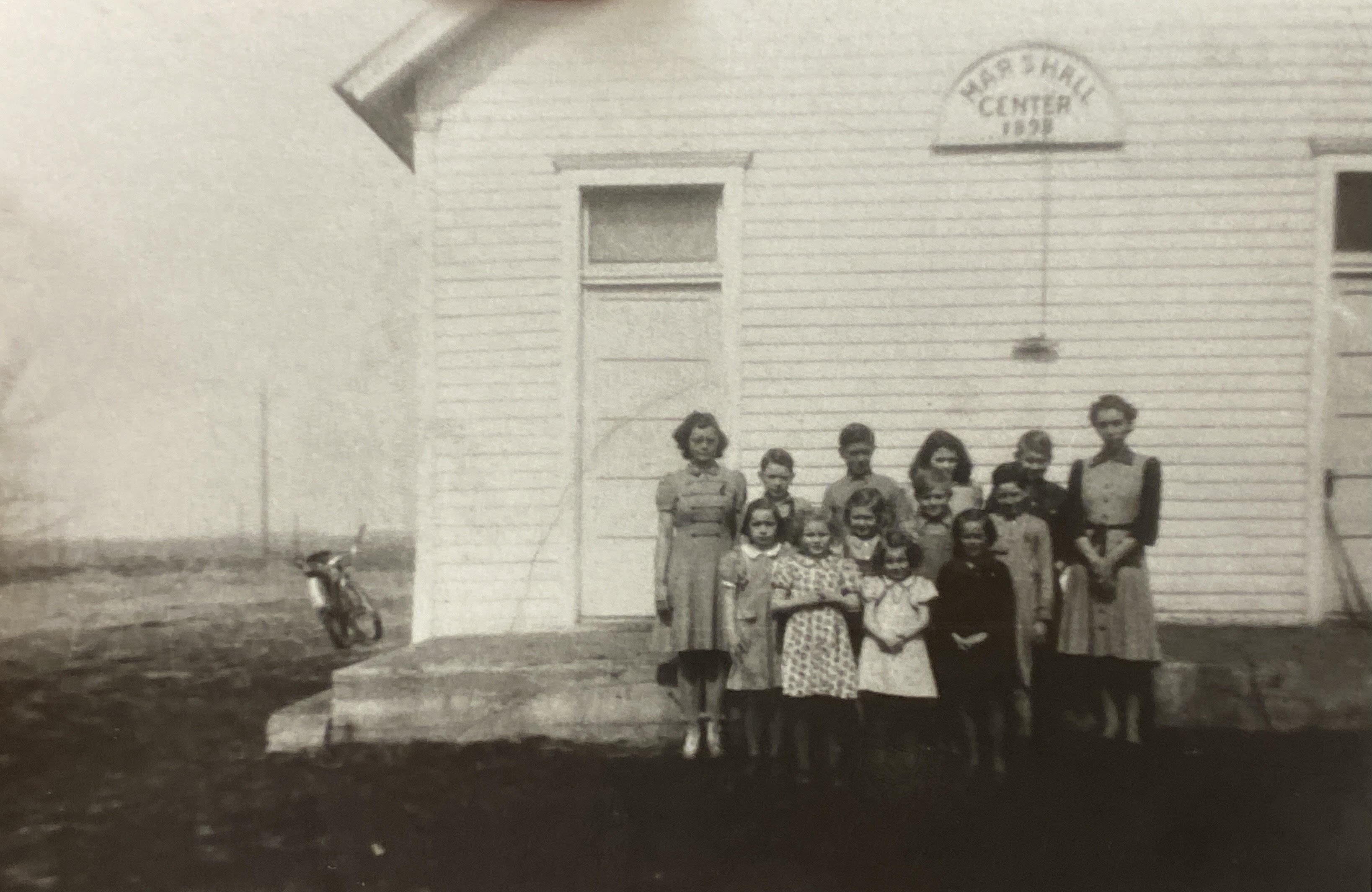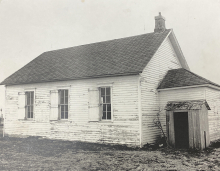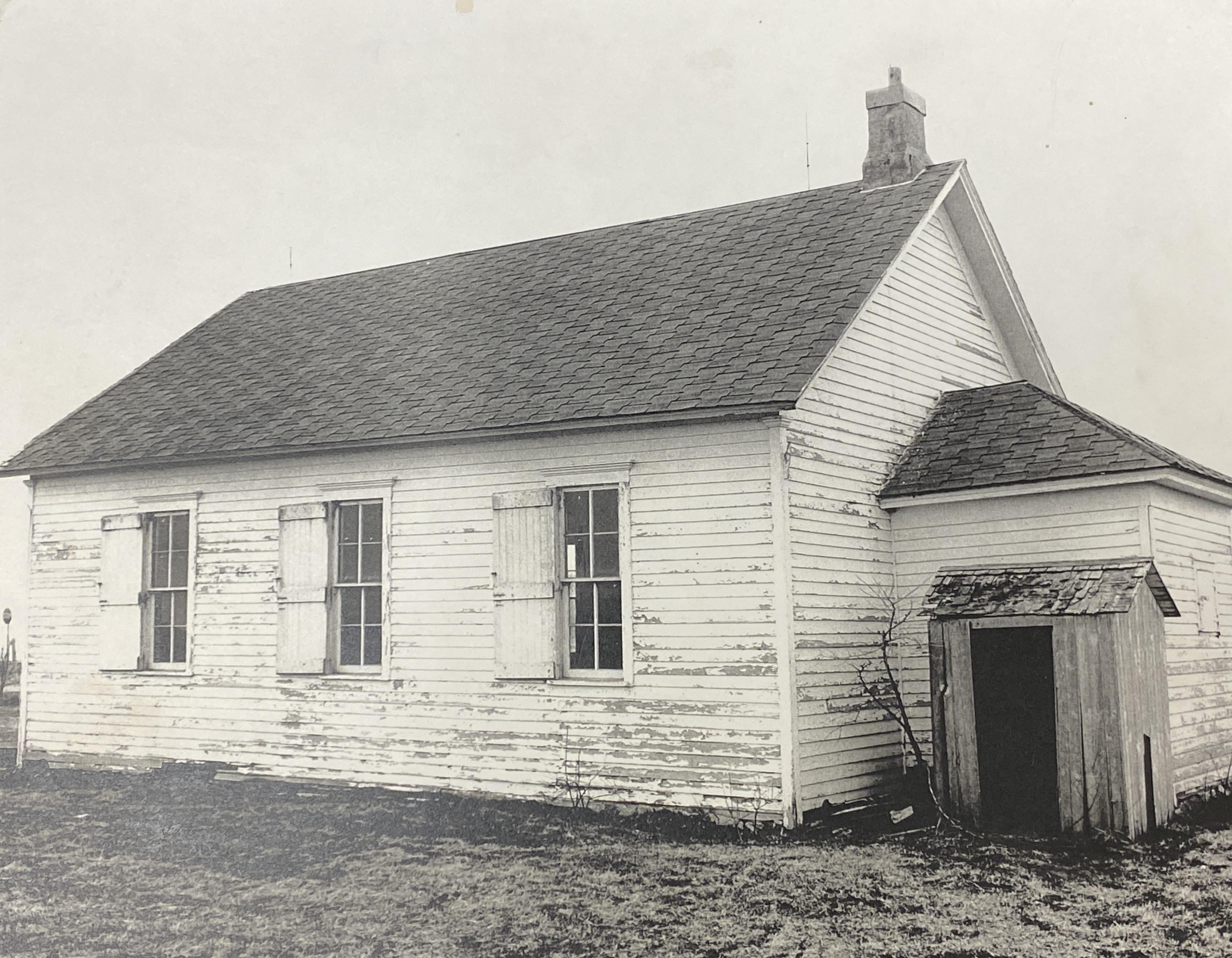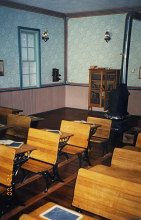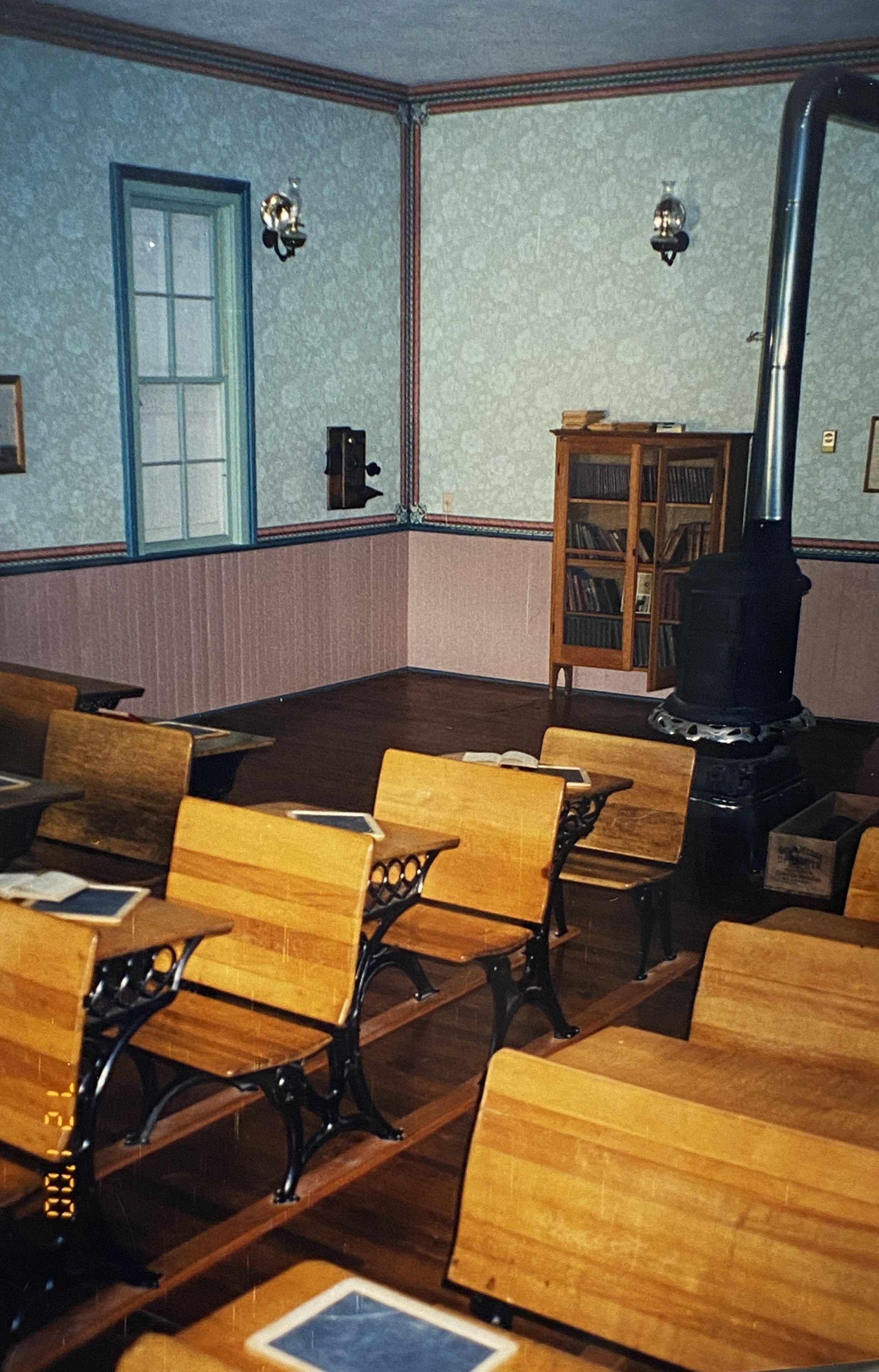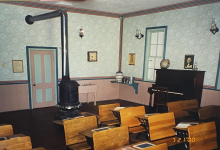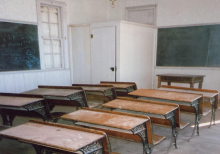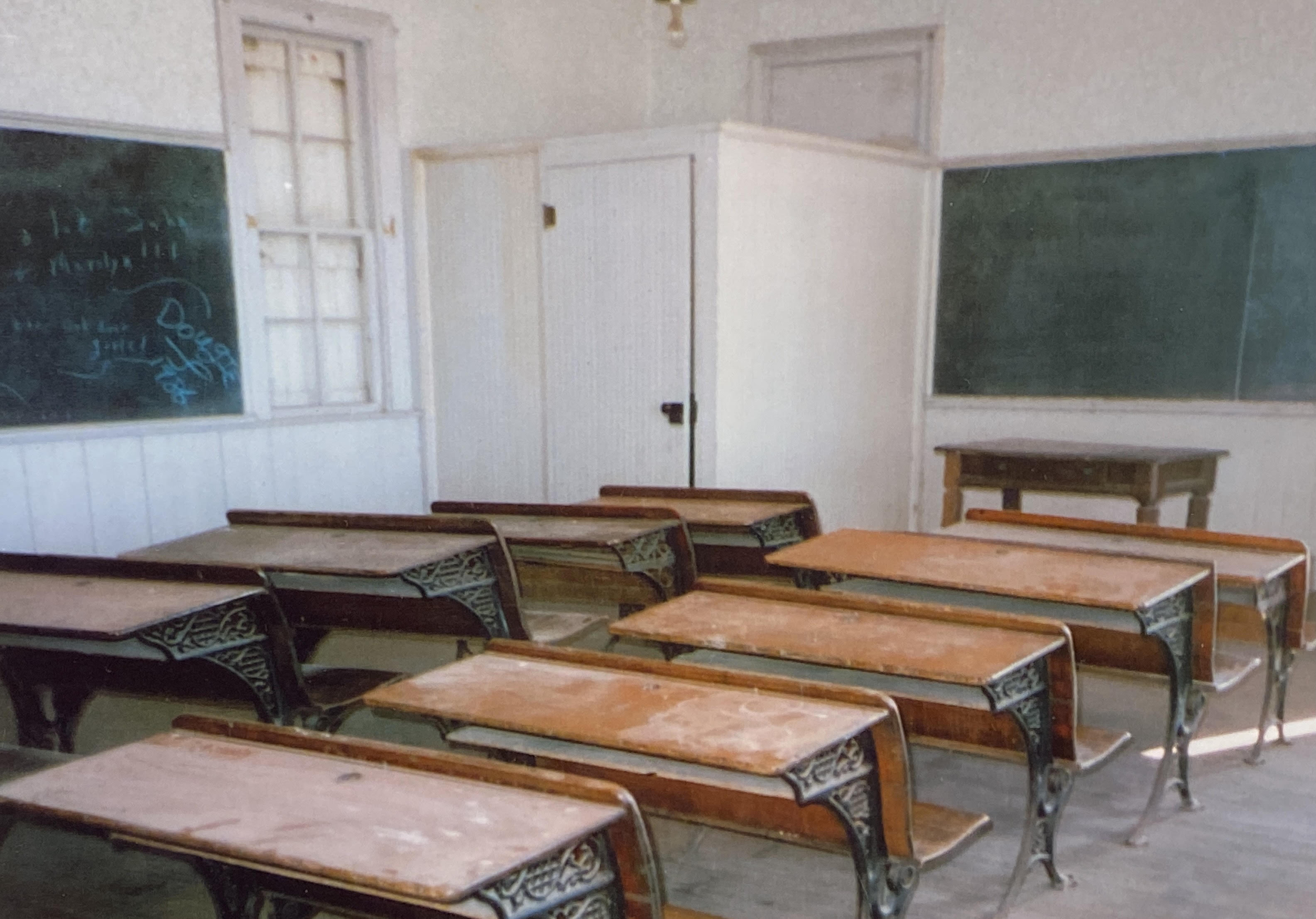Marshall Center School (Current Location)
The Building The Marshall Center School (MCS) was built in 1893 in the Marshall Township of Pocahontas County, at the request of the Township School Board. The building of the MCS was approved by the School Board on April 29, and on September 18 the School Board held their fall meeting in the new schoolhouse. It was built by L. N. Ellis & Son at the cost of $730. $25 was paid to C. J. Bennett for the one acre of land for the School. The Board minutes show that $120.02 was paid for new furniture for the school, but no details were given as to exactly what was bought. In all probability, the furniture included school desks, teacher's chair and table, blackboards, wallpaper and curtains. The style of the School is very typical of Iowa's rural schools: one-room rectangle, architecturally simple, small, clapboard sided, exterior rooftop chimney, 6 four-over-four windows, south-facing front entrance and fieldstone foundation. The doors faced south, to catch the sun and to avoid the winter winds from the northwest. The lack of an outside entry or inside cloakrooms was not common but not unheard of. Less common are the two entrances, one for girls and one for boys. Because the MCS was built by a builder and not by the community, it may have been done from an architect's plan. Such basic plans had been available since the 1830s, but most communities or school boards greatly simplified the final school architecture. Such simplicity certainly belies the importance of rural schools, since they were vital centers of education, culture and community gatherings. But the Marshall Township School Board apparently chose not to use their funds to create elaborate school buildings with belfries or decoration. Such elaborations were not even added in the early 20th century when other parts of the country were building on such items as ornate bell towers. The MCS building is one room with an attached coal shed. It is assumed that the single outside shutters, front "porch" platform and outhouses were also built at this time. It is not known when the outside well was dug or when a flagpole was attached to the front of the building, though the latter was probably added after 1900 when interest in Americanization increased. A fence was put around the one-acre lot in 1896 and again in 1902, the latter being a woven-wire fence. Lightning rods were attached to the building in 1907. The School Board repeatedly tried to get trees in the township schoolyards, authorizing plantings in 1896 ("2 dozen shade trees") and sometime between 1908 and 1910 ("twelve shade trees"). A late interior change to the building occurred around 1940 when two small cloakrooms were added to the interior of the building, just at the entrance of each door. There is some question as to whether the teacher's desk was on a platform. There is no question that the MCS had wallpaper. It is probable that all schoolhouses in the township were papered, since wallpaper and curtains were accepted township school expenses even in September 1887. In 1988, when the MCS was moved to the University of Northern Iowa campus and restoration was undertaken of the building, 6 or 7 different layers of wallpaper were found on the walls. It is known that the Board approved repapering in 1904, so it is probable that the MCS was papered approximately every 6 to 10 years. A privy (outhouse) was also built or rebuilt in 1904. There is no mention of curtains in the School Board minutes, but a 1910 photo of the school interior shows full lace curtains on the windows. Oral histories recount that these had been replaced by flowered cafe curtains around 1917. The presidential portraits seen in the photo are typical of the process of Americanization and assimilation of immigrants after 1900. A telephone was installed sometime in the 1920s, apparently because of the threat of tornadoes. Electricity was not added until much later, in 1937 or 1938. By 1946, when the Alvin & Bernice Lindquist bought the adjoining farm, there was only one dilapidated privy remaining, no shade trees, and no telephone connection. This was after the MCS had only been closed for two years. The telephone was probably disconnected during the Depression due to lack of funds. Maintenance of the School Building The School Board voted each year to levy a certain amount of money to run the township schools. School expenses included building repairs, furniture, basic school supplies, textbooks, maps, dictionaries, wallpaper, paint and coal. But monies were also set aside for hauling coal, mowing the school yard, cleaning the school and building fires within the school pot-bellied stove. Rather than volunteering their time or that of school neighbors time for major maintenance, the School Board always paid others to do these tasks. Minor repairs and changes were handled by the director of each school. In the case of cleaning the school and building the fires, these tasks were carried out by the teacher. In 1887, in Marshall Township, teachers were given $1/month to build fires. One year later, they were to do it for free. The next year, they were given $5 for the winter term to build fires. In 1892, they were given $3 during the winter term for janitorial work. Then in 1894, there was no money for fires. The decline in payment probably reflects the national economic crisis in the late 1880s and early 1890s. After this date, little mention is made of giving the teacher money for building fires or for janitorial work until the 1920s when the teacher at MCS was given $5 extra per month for janitorial work because of all the extra events occurring at this school. The School Director, with Board approval, was responsible for getting the lawn mowed and buying school supplies and coal, but the teacher was still responsible for building the fire and cleaning the school on a routine basis. However in response to the Depression, only $3 was paid out in 1929 for the scrubbing of each schoolhouse in the township. Original Parts of Marshall Center School There are many original elements of the Marshall Center School still left in the building. The basic building, with coal shed, is original excluding the front doors which had to be rebuilt after the School was moved to campus. Though the shutters are original, these were not added to the building until the 1930s. It is not known if any of the window glass is original. The two rows of double desks and blackboards are original to the building. Like most Iowa rural schoolhouses, the MCS was probably always painted white. The hemispheric sign on the front of the building is original, though it is not known when it was put in place. The current wallpaper is reproduction paper, selected as similar to the original MCS wallpaper dating to 1910-1920. The wall "lanterns" are reproduction pieces as well, though similar to ones seen in the 1910 classroom photograph. The platform on the front exterior is reproduction, based on oral histories of former students. The plantings around the building are conjecture, but were plants frequently used in the early part of the 20th century. Pieces added to the interior, based on oral histories, are the extra desks, recitation bench, portraits of Lincoln and Washington, coal stove, sand box, water shelf and book case. The interior cloakrooms, added around 1940, were removed from the building during the renovation as not typical of the main period of the MCS's use. Because the chimney was not stable and could not be easily supported by the roof structure, it was removed. School Day and Term Schedules Classes probably began at 9:00 am, since this is the hour by which the teacher was to have the schoolroom warm (1894 School Board minutes). No mention is made in the School Board minutes of a required ending hour of the school day. However teacher records show that in the early 1920s, the school day ended at 4:00 pm. Before 1893 (when MCS was built), there was a 3-month summer term and a 4-month winter term. But the length of terms seems to have been flexible. One year there are two 3-month terms; the next year there are two terms of unequal length. Over time, the length of the total annual school term was gradually increased. In 1894, there were 7 months of school; in 1896, 8 months. In 1900, the 8 months were divided into a 2-month fall term (September and October), a 4-month winter term (mid-November through mid-March), and a 2-month spring term (April and May). It was not until 1922 that the number of months of school was increased to 9 months. The school year was extended through June and the two fall and spring breaks were continued. Unlike today, there was no long break around the Christmas holiday. The beginning and ending dates of each term were established by the director of each school. The Marshall Township School Board minutes do not mention any standard dates (from 1893 to 1944). However the minutes of the 1890s suggest that the winter term began near December 1. School Subjects Of greatest importance in early schools were reading, grammar and orthography (spelling). This was the basis of an educated person, though comprehension was not necessarily a part of the lesson. Students could spell large words but didn't always know what they meant. The next most important symbol of an educated person was penmanship. From first to eighth grade, students were required to practice, practice, practice their penmanship. The elaborate cursive script taught by the Spencerian method gave way at the end of the 1900s to a cleaner and more legible script known as the Palmer method of penmanship. Arithmetic was important for students to learn, as farmers needed to know about grain prices and yields per acre. By the turn of the century problems within arithmetic textbooks were related to everyday problems that any student's family might need to solve. Next most important were recitation and elocution. Students were required to memorize and recite long passages, speeches and poems from well-known authors. Their recitations were not just in the classroom, but provided entertainment at community public gatherings. The final subjects were history, geography, physiology and health. These, like the other, subjects, were to install a sense of civic pride and moral duty. Historic figures were used as role models to make students the ideal citizens. Inspirational sayings were used as copy material for penmanship. Physiology was added in the 1880s, in part as a response to the temperance movement. Music was one of the last subjects to be added to the rural school curriculum. By the turn of the century, schools were adding organs and pianos to the classroom to begin and end of the day of schooling. Marshall Center School received its piano in 1922. School Textbooks Beginning in 1891 and into the 1930s, the Marshall Township ordered textbooks from the American Book Company in Chicago, Illinois. In 1907, the following books were ordered by the Marshall Township School Board for use at all of the nine township schools, including the Marshall Center School: Baldwin's Primer (readers for first thru seventh year) Barns reader Natural Elementary Geography Milne's Elementary Arithmetic Overtone's Primary Physiology Modern Speller McMaster's Primary History Spencerian Copy Books Maxwells Elementary English Grammar Webster's Primary Dictionary It is interesting that the Spencer penmanship books were ordered at this late date, since this was considered old-fashioned by the latter part of the 1800s. The Spencer method had been replaced in many U.S. schools by the Palmer method which was a less elaborate style of handwriting. The Palmer method was considered more efficient for business purposes. Though the School Board had ordered books for all the township schools prior to 1916, after this date they voted specifically to achieve uniformity of textbooks throughout the township. This is probably a result of the increasing role of the County Superintendent of Schools seen throughout Iowa. During the first quarter of the 20th Century, there is a greater emphasis at the state and county levels placed on school consolidations, uniformity of textbooks, teaching methods, teacher pay and teacher qualifications. In 1900 Iowa had the highest literacy rate in the country. Even in the early 1890s, the School Board of a newly settled and thinly populated county like Pocahontas was ordering standard textbooks and dictionaries for their small rural schools. This is surely a reflection of the value placed on a good education by the people of Iowa. Teacher Wages In 1889, first "grade" teachers' wages were set at $30/month for summer term and $35/month for winter term; the second "grade" teachers' wages were $25/month for summer term and $30/month for winter term. These wages remained the same until 1897 when the wages were actually lowered by $2/month! But in 1898, the School Board discontinued the practice of paying less in the summer time and went to a standard monthly salary regardless of the term. The "grades" of teachers refer not to class levels but the level of training of the teacher. Though the Board minutes do not specify the qualifications for each grade, it is assumed that third-grade teachers had successfully completed the 8th grade exam certificate, second-grade had attended summer teacher institutes, and first-grade had normal school teacher training (post 8th grade education). At some date, teachers were required to take an examination periodically to maintain their teaching "grade". Wages apparently went up and down with the local economy. Through time a first-grade teacher's monthly salary was: $32 in 1897 $40 in 1899 $36 in 1900 $38 in 1904 $40 in 1906 $44 in 1909 $85 in 1923 $45 in 1933 (Depression) In 1913, the minutes mention that teacher wages are "paid as fixed by law." In 1917, there is mention of a minimum wage. Either at the county or state level, teacher wages began being regulated during this time period, probably in an attempt to stabilize income for teachers whose income fluctuated at the whim of the local school board. From this time onward, teacher wages were set at the state minimum by the School Board. The wages are then set by the School Board at $5 to $10 over the minimum wage set by law. An interesting variant on this was in 1923, when the School Board rewarded teachers who stayed at a school and taught a second year. In 1931 they gave a bonus of $10 per month for staying at a school for three or more years. Whereas in the late 1800s when communities either did not expect or did not want teachers to stay more than one term (not even one year), the second quarter of the 1900s shows that school boards wanted teachers to stay much longer. In 1932, teachers signed a contract agreeing to work 9 months for 8 months pay. They were also given warrants (pay vouchers) instead of money, with 4% interest. We must assume that this was a reaction to the Great Depression of the 1930s, when school boards were probably hard pressed to find money to pay teachers. It was also at this time (1933) that the Marshall Township School Board officially decided not to hire any married women. This was common during the Depression, as it was felt that the few available jobs should be shared between families. Since married women were secondary wage earners, they were not to take up jobs needed by single men and women. But this is the first time that married women were excluded from hiring and that at no time was there an official mention in the school board minutes of a difference between the salaries of male and female teachers. Starting in 1902, teachers were paid for Christmas if it fell on a school day. But it was not until 1910 that holidays were allowed for teachers. Always Christmas and New Year's Day were allowed, and sometimes Decoration Day and Thanksgiving. These latter days are interesting as they signal the longer school term that crossed into planting and harvesting times. In 1914, teachers were allowed to attend a teachers institute in September. Further research will have to be done to see how long teachers really stayed at MCS and whether the pay of male and female teachers was the same. We know that several of the MCS teachers were former MCS students, but a review of county records [in future research] will give us an idea of how many teachers were "locals". Eventually the teacher list will also be compared to county teacher institute and ISNS/ISTC records to learn about their level of teacher training. Teacher Living Arrangements It is interesting that no mention is made in the School Board minutes of living arrangements for any teachers in the Marshall Township. Only wages and payment for extra duties are discussed. Presumably the individual directors of each school district had responsibility for helping their teacher to find room and board, but the minutes do not mention that the Board gave over this responsibility to each director. Written information on the teacher's room and board may never have existed. At times, these amenities were provided by a wealthy family living near the school. An alternative free arrangement involved a rotation between homes in the vicinity of the school, an arrangement that required the teacher to change lodgings frequently. At other times, the teacher was required to pay a family a small fee for room and board. During the 1910s and 1920s, we know that the MCS teachers boarded with the Coffmans, a childless couple with a farm 1/2 mile south of the school. Former students remember that the Coffmans enjoyed the teacher's company. It is not known if they charged room and board. Marshall Center School as Community Center As soon as it was built in 1893, the Marshall Center School served as the meeting place of the Township School Board until 1944 when it closed. It was also used as a voting place, from its creation in 1893 until 1986. Around the turn of the century, church services were held here by Lutheran and Methodist congregations before these groups had built their own churches. 4-H club meetings were held often in the School during the 1920s and 1930s. Meetings of the Farm Bureau and the Women's Farm Bureau were also held at the School on Thursday evenings during this period. Because the MCS was used for community activities so much, the School Board always gave its teacher more money for janitorial work. This may also have been the reason for the installation of a telephone. However it does seem from the School Board minutes that MCS did not receive very many special amenities or considerations. The Marshall Center School was built in 1893 near Laurens, in Pocahontas County, Iowa. Until 1944, it operated as a school for grades one through eight, and as an occasional meeting place for church congregations and clubs. From its opening in 1893 until 1986, the School was an official polling place. In 1987, the School was moved to UNI to commemorate the campus' beginning as a teachers college and to honor all the teachers who graduated from the campus. Today, the School serves as an historic site with educational programs for campus and the general public. Photo credit: Photo #1: Google Maps, 2021, Photo #2: FI0016303, Laurens, IA, 1900 by University of Northern Iowa Museum/Fortepan Iowa, https://fortepan.us/categories/all/FI0016303, CC-BY-SA 4.0, Photos #3-#8: UNI Museum.

